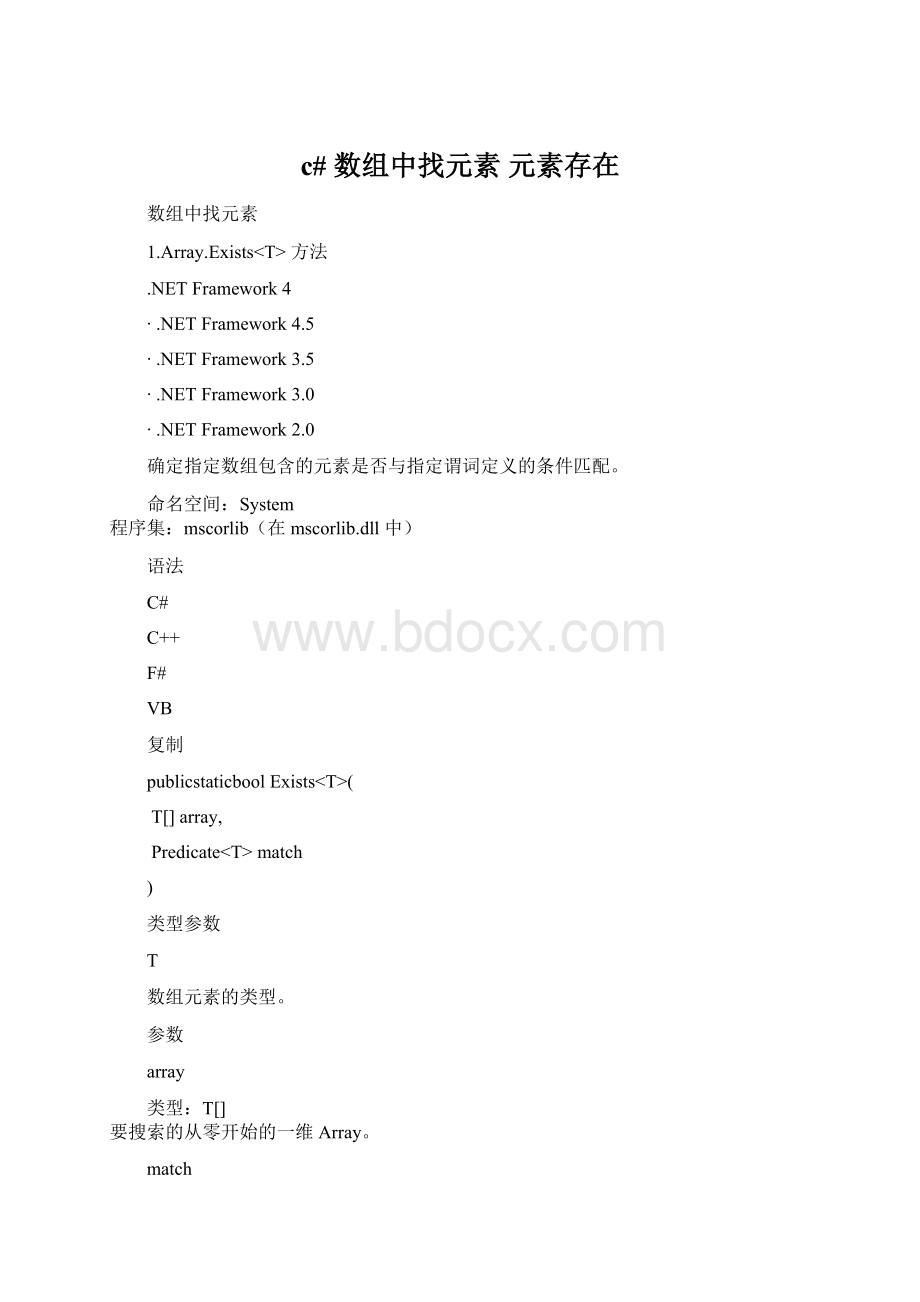c# 数组中找元素 元素存在.docx
《c# 数组中找元素 元素存在.docx》由会员分享,可在线阅读,更多相关《c# 数组中找元素 元素存在.docx(14页珍藏版)》请在冰豆网上搜索。

c#数组中找元素元素存在
数组中找元素
1.Array.Exists方法
.NETFramework4
∙.NETFramework4.5
∙.NETFramework3.5
∙.NETFramework3.0
∙.NETFramework2.0
确定指定数组包含的元素是否与指定谓词定义的条件匹配。
命名空间:
System
程序集:
mscorlib(在mscorlib.dll中)
语法
C#
C++
F#
VB
复制
publicstaticboolExists(
T[]array,
Predicatematch
)
类型参数
T
数组元素的类型。
参数
array
类型:
T[]
要搜索的从零开始的一维Array。
match
类型:
System.Predicate
Predicate,定义要搜索的元素的条件。
返回值
类型:
System.Boolean
如果array包含一个或多个元素与指定谓词定义的条件匹配,则为true;否则为false。
异常
异常
条件
ArgumentNullException
array为null。
-或-
match为null。
备注
Predicate是对方法的委托,如果传递给它的对象与委托中定义的条件匹配,则该方法返回true。
array的元素被逐个传递给Predicate,找到一个匹配项时处理就会停止。
此方法的运算复杂度为O(n),其中n是array的Length。
示例
下面的代码示例演示Exists泛型方法和使用Predicate泛型委托的其他几种泛型方法。
创建一个包含8个恐龙名称的字符串数组,其中有2个名称(分别位于位置1和5)以“saurus”结尾。
该代码示例还定义了一个名为EndsWithSaurus的搜索谓词方法,该方法接受一个字符串作为参数,并返回一个布尔值,指示输入的字符串是否以“saurus”结尾。
Exists方法在预测方法为其返回true的第一个元素(在本例中为“Amargasaurus”)处停止并返回true。
注意
在C#和VisualBasic中,不必显式创建Predicate委托(在VisualBasic中为Predicate(OfString))。
这些语言会通过上下文推知正确的委托,并自动创建委托。
TrueForAll泛型方法在预测方法为其返回false的第一个元素处停止并返回false。
Find泛型方法从开始处遍历数组,依次将每个元素传递给EndsWithSaurus方法。
当EndsWithSaurus方法对元素“Amargasaurus”返回true时,搜索停止。
使用FindLast泛型方法从末尾处向后搜索数组。
它在位置5处找到元素"Dilophosaurus"。
FindAll泛型方法用于返回包含以"saurus"结尾的所有元素的数组。
显示这些元素。
C#
C++
VB
复制
usingSystem;
publicclassDinoDiscoverySet
{
publicstaticvoidMain()
{
string[]dinosaurs=
{
"Compsognathus","Amargasaurus","Oviraptor",
"Velociraptor","Deinonychus","Dilophosaurus",
"Gallimimus","Triceratops"
};
DinoDiscoverySetGoMesozoic=newDinoDiscoverySet(dinosaurs);
GoMesozoic.DiscoverAll();
GoMesozoic.DiscoverByEnding("saurus");
}
privatestring[]dinosaurs;
publicDinoDiscoverySet(string[]items)
{
dinosaurs=items;
}
publicvoidDiscoverAll()
{
Console.WriteLine();
foreach(stringdinosaurindinosaurs)
{
Console.WriteLine(dinosaur);
}
}
publicvoidDiscoverByEnding(stringEnding)
{
PredicatedinoType;
switch(Ending.ToLower())
{
case"raptor":
dinoType=EndsWithRaptor;
break;
case"tops":
dinoType=EndsWithTops;
break;
case"saurus":
default:
dinoType=EndsWithSaurus;
break;
}
Console.WriteLine(
"\nArray.Exists(dinosaurs,\"{0}\"):
{1}",
Ending,
Array.Exists(dinosaurs,dinoType));
Console.WriteLine(
"\nArray.TrueForAll(dinosaurs,\"{0}\"):
{1}",
Ending,
Array.TrueForAll(dinosaurs,dinoType));
Console.WriteLine(
"\nArray.Find(dinosaurs,\"{0}\"):
{1}",
Ending,
Array.Find(dinosaurs,dinoType));
Console.WriteLine(
"\nArray.FindLast(dinosaurs,\"{0}\"):
{1}",
Ending,
Array.FindLast(dinosaurs,dinoType));
Console.WriteLine(
"\nArray.FindAll(dinosaurs,\"{0}\"):
",Ending);
string[]subArray=
Array.FindAll(dinosaurs,dinoType);
foreach(stringdinosaurinsubArray)
{
Console.WriteLine(dinosaur);
}
}
//Searchpredicatereturnstrueifastringendsin"saurus".
privateboolEndsWithSaurus(strings)
{
if((s.Length>5)&&
(s.Substring(s.Length-6).ToLower()=="saurus"))
{
returntrue;
}
else
{
returnfalse;
}
}
//Searchpredicatereturnstrueifastringendsin"raptor".
privateboolEndsWithRaptor(Strings)
{
if((s.Length>5)&&
(s.Substring(s.Length-6).ToLower()=="raptor"))
{
returntrue;
}
else
{
returnfalse;
}
}
//Searchpredicatereturnstrueifastringendsin"tops".
privateboolEndsWithTops(Strings)
{
if((s.Length>3)&&
(s.Substring(s.Length-4).ToLower()=="tops"))
{
returntrue;
}
else
{
returnfalse;
}
}
}
/*Thiscodeexampleproducesthefollowingoutput:
Compsognathus
Amargasaurus
Oviraptor
Velociraptor
Deinonychus
Dilophosaurus
Gallimimus
Triceratops
Array.Exists(dinosaurs,"saurus"):
True
Array.TrueForAll(dinosaurs,"saurus"):
False
Array.Find(dinosaurs,"saurus"):
Amargasaurus
Array.FindLast(dinosaurs,"saurus"):
Dilophosaurus
Array.FindAll(dinosaurs,"saurus"):
Amargasaurus
Dilophosaurus
*/
2.Array.Find方法
.NETFramework4.5
其他版本
命名空间:
System
程序集:
mscorlib(在mscorlib.dll中)
语法
C#
C++
F#
VB
复制
publicstaticTFind(
T[]array,
Predicatematch
)
类型参数
T
数组元素的类型。
参数
array
类型:
T[]
要搜索的从零开始的一维Array。
match
类型:
System.Predicate
Predicate,定义要搜索的元素的条件。
返回值
类型:
T
如果找到与指定谓词定义的条件匹配的第一个元素,则为该元素;否则为类型T的默认值。
异常
异常
条件
ArgumentNullException
array为null。
-或-
match为null。
备注
Predicate是对方法的委托,如果传递给它的对象与委托中定义的条件匹配,则该方法返回true。
array的元素被逐个传递给Predicate,在Array中向前移动,从第一个元素开始,到最后一个元素结束。
当找到匹配项时处理即停止。
此方法的运算复杂度为O(n),其中n是array的Length。
示例
下面的代码示例将Predicate委托与Find泛型方法一起使用以搜索Point结构的数组。
如果X和Y字段的产品大于100,000,则该代理所代表的方法ProductGT10将返回true。
Find方法调用数组的每个元素的代理,从而在第一个满足测试条件的点返回。
说明
VisualBasic和C#用户不需要显式创建委托,也不需要指定泛型方法的类型参数。
编译器会根据您提供的方法参数确定必需的类型。
C#
VB
复制
usingSystem;
usingSystem.Drawing;
publicclassExample
{
publicstaticvoidMain()
{
//CreateanarrayoffivePointstructures.
Point[]points={newPoint(100,200),
newPoint(150,250),newPoint(250,375),
newPoint(275,395),newPoint(295,450)};
//TofindthefirstPointstructureforwhichXtimesY
//isgreaterthan100000,passthearrayandadelegate
//thatrepresentstheProductGT10methodtothestatic
//FindmethodoftheArrayclass.
Pointfirst=Array.Find(points,ProductGT10);
//Notethatyoudonotneedtocreatethedelegate
//explicitly,ortospecifythetypeparameterofthe
//genericmethod,becausetheC#compilerhasenough
//contexttodeterminethatinformationforyou.
//Displaythefirststructurefound.
Console.WriteLine("Found:
X={0},Y={1}",first.X,first.Y);
}
//ThismethodimplementsthetestconditionfortheFind
//method.
privatestaticboolProductGT10(Pointp)
{
if(p.X*p.Y>100000)
{
returntrue;
}
else
{
returnfalse;
}
}
}
/*Thiscodeexampleproducesthefollowingoutput:
Found:
X=275,Y=395
*/
3.Array.IndexOf方法(Array,Object)
.NETFramework4.5
∙.NETFramework4
∙.NETFramework3.5
∙.NETFramework3.0
∙.NETFramework2.0
搜索指定的对象,并返回整个一维Array中第一个匹配项的索引。
命名空间:
System
程序集:
mscorlib(在mscorlib.dll中)
语法
C#
C++
F#
VB
复制
publicstaticintIndexOf(
Arrayarray,
Objectvalue
)
参数
array
类型:
System.Array
要搜索的一维Array。
value
类型:
System.Object
要在array中查找的对象。
返回值
类型:
System.Int32
如果在整个array中找到value的匹配项,则为第一个匹配项的索引;否则为该数组的下限减1。
异常
异常
条件
ArgumentNullException
array为null。
RankException
array是多维的。
备注
向前搜索一维Array,从第一个元素开始,到最后一个元素结束。
使用Object.Equals方法,将元素与指定的值进行比较。
如果元素类型是非内部(用户定义)类型,则使用该类型的Equals实现。
由于大多数数组以零作为下限,在找不到value时,此方法通常将返回-1。
在极少数情况下,数组的下限等于Int32.MinValue,且找不到value,这时此方法返回Int32.MaxValue,即System.Int32.MinValue-1。
此方法的运算复杂度为O(n),其中n是array的Length。
在.NETFramework2.0版中,此方法使用Array的Equals和CompareTo方法来确定由value参数指定的Object是否存在。
在早期版本的.NETFramework中,这是通过使用Equals和valueObject本身的CompareTo方法来确定的。
示例
下面的代码示例显示如何确定指定元素的第一个匹配项的索引。
C#
C++
VB
复制
usingSystem;
publicclassSamplesArray{
publicstaticvoidMain(){
//CreatesandinitializesanewArraywiththreeelementsofthesamevalue.
ArraymyArray=Array.CreateInstance(typeof(String),12);
myArray.SetValue("the",0);
myArray.SetValue("quick",1);
myArray.SetValue("brown",2);
myArray.SetValue("fox",3);
myArray.SetValue("jumps",4);
myArray.SetValue("over",5);
myArray.SetValue("the",6);
myArray.SetValue("lazy",7);
myArray.SetValue("dog",8);
myArray.SetValue("in",9);
myArray.SetValue("the",10);
myArray.SetValue("barn",11);
//DisplaysthevaluesoftheArray.
Console.WriteLine("TheArraycontainsthefollowingvalues:
");
PrintIndexAndValues(myArray);
//Searchesforthefirstoccurrenceoftheduplicatedvalue.
StringmyString="the";
intmyIndex=Array.IndexOf(myArray,myString);
Console.WriteLine("Thefirstoccurrenceof\"{0}\"isatindex{1}.",myString,myIndex);
//SearchesforthefirstoccurrenceoftheduplicatedvalueinthelastsectionoftheArray.
myIndex=Array.IndexOf(myArray,myString,4);
Console.WriteLine("Thefirstoccurrenceof\"{0}\"betweenindex4andtheendisatindex{1}.",myString,myIndex);
//SearchesforthefirstoccurrenceoftheduplicatedvalueinasectionoftheArray.
myIndex=Array.IndexOf(myArray,myString,6,5);
Console.WriteLine("Thefirstoccurrenceof\"{0}\"betweenindex6andindex10isatindex{1}.",myString,myIndex);
}
publicstaticvoidPrintIndexAndValues(ArraymyArray){
for(inti=myArray.GetLowerBound(0);i<=myArray.GetUpperBound(0);i++)
Console.WriteLine("\t[{0}]:
\t{1}",i,myArray.GetValue(i));
}
}
/*
Thiscodeproducesthefollowingoutput.
TheArraycontainsthefollowingvalues:
[0]:
the
[1]:
quick
[2]:
brown
[3]:
fox
[4]:
jumps
[5]:
over
[6]:
the
[7]:
lazy
[8]:
dog
[9]:
in
[10]:
the
[11]:
barn
Thefirstoccurrenceof"the"isatindex0.
Thefirstoccurrenceof"the"betweenindex4andtheendisatindex6.
Thefirstoccurrenceof"the"betweenindex6andindex10isatindex6.
*/
版本信息
.NETFramework
受以下版本支持:
4.5、4、3.5、3.0、2.0、1.1、1.0
.NETFrameworkClientProfile
受以下版本支持:
4、3.5SP1
可移植类库
受以下版本支持:
可移植类库
适用于Windows应用商店应用的.NET
受以下版本支持:
Windows8
平台
Windows8,WindowsServer2012,Windows7,WindowsVistaSP2,WindowsServer2008(不支持服务器核心角色),WindowsServer2008R2(支持带SP1或更高版本的服务器核心角色;不支持Itanium)
.NETFramework并不是对每个平台的所有版本都提供支持。
有关支持的版本的列表,请参见.NETFramework系统要求。
请参见
参考
Array类
IndexOf重载
System命名空间
LastIndexOf
其他资源